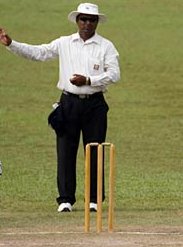
 |
| Index | |
|
|
|
|
|
| No ball  A No ball, which does not count as one of the over, earns an automatic penalty of one run awarded to the batting side, together with any other runs that may have accrued from it. This penalty run is always added to the score whether or not other runs or penalties are scored or disallowed The ball does not become dead at the call of No ball, but batters can only be dismissed from a No ball Run out, Hit the ball twice, Handled the ball, or Obstructing the field There are several reasons why an umpire might call and signal a delivery as a No ball, but by far the commonest is what commentators usually refer to as a 'foot-fault' or 'overstepping' by the bowler. The Laws put constraints on where a bowler can bowl from - otherwise anarchy would ensue! When a bowler's front foot lands in his delivery stride, some part of it must be behind the line marking the popping crease at his end. It doesn't matter whether that part of the foot is grounded or raised up, just as long as some part of it is behind the line Any subsequent movement of the foot doesn't count. So, for example, if the front foot first lands with some part behind the popping crease, either on the ground or in the air, but then slips forward past the crease, that would not be grounds for calling a No ball Many people confuse the crease marking - the white line - with the crease itself. The crease is the inner edge of that line - the edge nearest the stumps at that end There is another kind of 'foot fault', one that often afflicts slow bowlers or those with a curving run-up. In his delivery stride, the bowler's back foot must land within and not touching the return crease. There is no question here of parts of feet behind lines - the bowler's foot must not even touch the inner edge of that return crease marking Other reasons for No ball being called and signalled include dangerous and unfair bowling - beamers, bouncers and the like, fielders encroaching on or over the pitch, or breaking the fielding limitation that when a ball is delivered there must be no more than two of them on the leg side behind the popping crease at striker's end Even the wicket-keeper can cause a No ball, if he fails to remain completely behind the wicket until the striker has started to run, or the ball has hit his bat or his person, or the ball has passed the wicket Rather unusual causes for a No ball are when the delivery fails to arrive at the striker - coming to rest on the pitch in front of the line of the striker's wicket, or when it either bounces three times or more or rolls along the ground before it reaches the striker's popping crease But by far the most controversial reason for awarding a No ball is when an umpire believes that the bowler is not bowling the ball, but throwing it! |
||||||